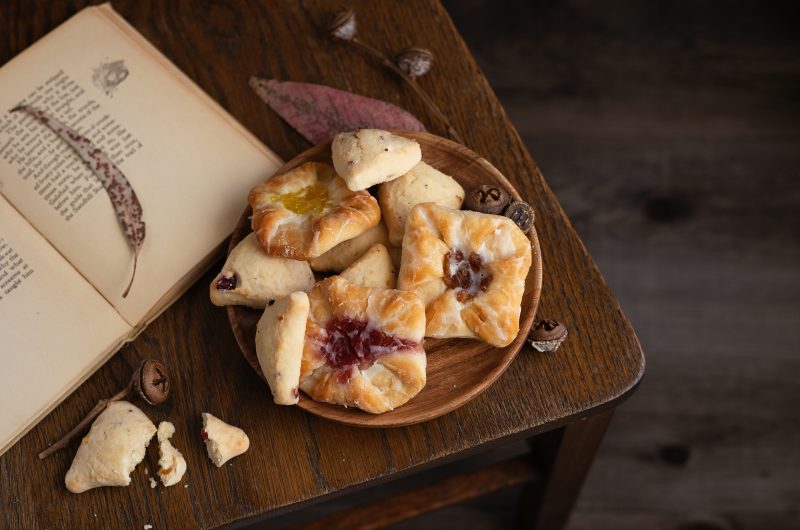
ABOUT THE ART
Kierkegaard, Niels Christian. Portrait of Søren Kierkegaard. 1830-1882.
Søren Kierkegaard – September 8th
Kierkegaard is not one of the traditional saints. First of all, he was a Protestant, and secondly, he was a huge critic of the church of his day. Yet, he was a great Christian and a deep thinker. He is considered to be the father of existentialism and has inspired much modern thought, including many theologians like Karl Barth.
Kierkegaard may be best known for his belief that a “leap of faith” is required by all, and that Christians are called to live boldly freed from worldly attachments as “knights of faith.” We are remembering the Dane with what else but a Danish pastry.

Danish Pastries
Danish pastries, also known as "wienerbrød" in Denmark, are a type of laminated pastry that originated in Austria and were brought to Denmark in the 1800s by Austrian bakers. Danish pastries come in a variety of shapes, including crescents, braids, and twists, and are often filled with sweetened cream cheese, fruit preserves, or almond paste. They are commonly topped with a sweet glaze and are a popular breakfast pastry around the world.
Keep the screen of your device on
Ingredients
- Pastry Dough
32 tablespoons 32 unsalted butter, softened out of the refrigerator for 15 minutes
5 1/2 cups 5 1/2 All-Purpose Flour
1/3 cup 1/3 granulated sugar
4 teaspoons 4 instant yeast
2 1/2 teaspoons 2 1/2 salt
1/2 - 1 teaspoon 1/2 - 1 cardamom
1 teaspoon 1 vanilla
1 cup 1 milk, cold
1/3 cup 1/3 lukewarm water
2 large 2 eggs
- Cheese Filling
4 oz 4 cream cheese
1/2 cup 1/2 ricotta cheese
3 tablespoons 3 granulated sugar
1 large 1 egg
1/4 teaspoon 1/4 salt
- Fruit Fillings
Selection of jam or preserves of your choice. We used cherry, apricot, blueberry preserves.
- Egg Wash
1 large 1 egg white, beaten lightly with 1 tablespoon cold water
- Glaze
1 1/2 cups 1 1/2 confectioners’ sugar
2 - 2 1/2 tablespoons 2 - 2 1/2 milk
pinch salt
crushed nuts, optional; to garnish
Directions
- Begin by cutting 1/4? butter off the end of each of the 4 sticks; you’ll have about 2 tablespoons butter. Set them (and the remaining butter) aside. You’ll be using the 2 tablespoons butter immediately, but won’t need the remaining butter until after you’ve made the dough.
- In a large bowl, whisk together the flour, sugar, yeast, salt, and cardamom. Add the 2 tablespoons cold butter, working it in with your fingers until no large lumps remain.
- Add the vanilla, milk, water, and eggs. Mix and knead to make a cohesive, but quite sticky dough. This is easily done in a stand mixer with a dough hook, but it can also be done by hand.
- Scrape the dough into a ball, and transfer it to a floured work surface. Cover it with plastic wrap, and let it rest for 10 minutes while you prepare the butter.
- Cut each stick of butter in half lengthwise, to make 8 long rectangles. On a piece of floured parchment paper, line up 4 of the butter pieces side by side, to form a rectangle. Sprinkle lightly with flour, and cover with another piece of parchment paper.
- Gently pound and roll the butter until it’s about 6? x 9?.
- Repeat with the remaining 4 pieces of butter. You should now have two butter rectangles, about 6? x 9? each.
- Roll the dough into a rectangle about 12? wide and 24? long. It is OK to use dustings of flour to keep things from sticking.
- Place one of the butter pieces onto the center third of the dough. Fold one side over the butter to cover it. Place the other butter piece atop the folded-over dough, and fold the remaining dough up over it. You now have a rectangular “packet” of dough-enclosed butter. Pinch the open ends and side closed as best you can.
- Turn the dough 90°, so the 12? side is closest to you. Roll the dough into a 10? x 24? rectangle (approximately). Fold each side into the center; then fold one side over the other to make a rectangular packet about 6? x 10?.
- Dust the surface of the dough with flour, wrap it in plastic wrap, and chill in the refrigerator for about 20 minutes.
- Remove the dough from the fridge, and again roll it into a rectangle about 10? x 24?. Fold it into a packet as you did in step #10; it’ll be about 7? x 12?. Roll one final time, fold into a packet, and flour the dough lightly. Wrap loosely (but completely) in plastic, and chill it for 2 hours, or up to 16 hours; a long chill allows the dough to relax and rise to its fullest potential.
- Before shaping the pastries, select your fillings. We like to use a variety. To make the cheese filling, combine all of the ingredients, stirring until smooth. For the smoothest filling, process in a food processor.
- When you’re ready to make pastries, remove the dough from the refrigerator, unwrap it, and cut off one-third. You’ll work with this piece first; return the remainder to the fridge.
- Divide the dough into 12 pieces. Roll each into a smooth ball, then flatten the balls into 3? to 3 1/2? rounds, making the center thinner than the edges. You want to build up a slight wall of dough all around the circumference; this will help hold the filling. Place the rounds on a parchment-lined or lightly greased baking sheet.
- Working with one-half of the remaining dough at a time, repeat the process; you’ll finish with three baking sheets, each with 12 dough rounds.
- Cover the Danish lightly with greased plastic wrap, and let them rise for about 1 hour; they’ll become slightly puffy. Towards the end of the rising time, preheat the oven to 400°F.
- Use your fingers to press the centers of the dough rounds as flat as possible, leaving the “sidewalls” puffed. Spoon a slightly heaping measuring teaspoon of filling into the well of each round.
- Brush the exposed edges of pastry with the egg/water topping; this will create a satiny, golden crust.
- Bake the pastries for 15 to 18 minutes, until they’re golden brown. Rotate pans halfway through baking time. Remove them from the oven, and transfer to a rack. Glaze and serve immediately; or wait until they cool, then glaze.
- To make the glaze, whisk the confectioners’ sugar and salt with enough water or milk to make a “drizzle-able” glaze.
- Drizzle the glaze atop the pastries. Sprinkle with crushed nuts.